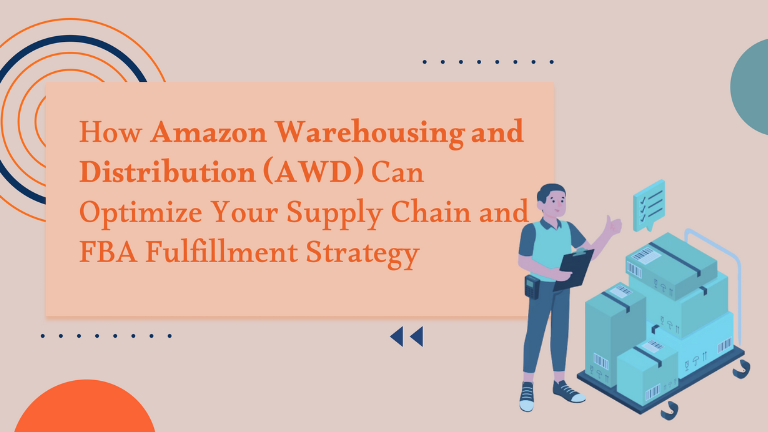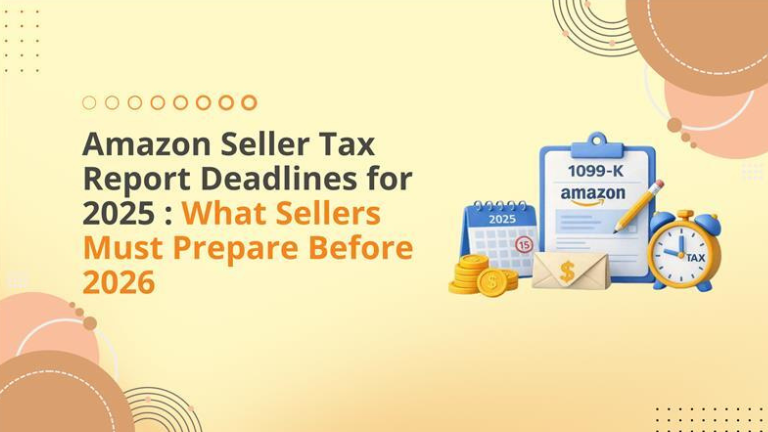As an Amazon seller, managing inventory and fulfillment costs can be a balancing act. Too much stock leads to high storage fees, especially during peak seasons, while too little inventory results in stockouts, missed sales, and dissatisfied customers. This is where Amazon Warehousing and Distribution (AWD) comes in, offering a smart solution to optimize your inventory management and fulfillment strategy.
Amazon Warehousing and Distribution (AWD) is Amazon’s long-term, bulk storage solution designed to help sellers store inventory at lower costs while still ensuring on-time fulfillment for customers. In this post, we’ll explore how Amazon Warehousing and Distribution (AWD) works, how it complements FBA, and how it can be the key to streamlining your supply chain.
Contents
- 1 What Is Amazon Warehousing and Distribution (AWD)?
- 2 Amazon Warehousing and Distribution (AWD) vs. FBA: What’s the Difference?
- 3 How Amazon Warehousing and Distribution (AWD) Can Optimize Your Existing FBA Strategy
- 4 Why Use Amazon Warehousing and Distribution (AWD)?
- 5 Quick Assessment: Is Amazon Warehousing and Distribution (AWD) Right for Your Business?
- 6 How to Get Started with Amazon Warehousing and Distribution (AWD)
- 7 Managing Amazon Warehousing and Distribution (AWD) Inventory
What Is Amazon Warehousing and Distribution (AWD)?
Amazon Warehousing and Distribution (AWD) is a storage service designed for long-term inventory management, offering cost-effective storage options for sellers with large quantities of inventory. Unlike FBA, which is focused on near-term order fulfillment, Amazon Warehousing and Distribution (AWD) acts as a buffer between bulk inventory storage and customer-ready inventory.
Here’s what Amazon Warehousing and Distribution (AWD) does:
- Stores bulk inventory for long periods at lower storage costs.
- Automatically replenishes FBA inventory when needed, ensuring your products stay stocked.
- Distributes inventory to non-Amazon sales channels (e.g., Shopify, Walmart).
- Integrates with Amazon’s fulfillment network to ensure smooth inventory flow.
This service is particularly beneficial for seasonal products, slow-moving inventory, and bulk purchases where long-term storage makes more sense than immediate fulfillment.
Amazon Warehousing and Distribution (AWD) vs. FBA: What’s the Difference?
While FBA (Fulfillment by Amazon) is all about quick and efficient order fulfillment, Amazon Warehousing and Distribution (AWD) focuses on long-term bulk inventory storage. Here’s a breakdown of the key differences:
| Feature | Amazon Warehousing and Distribution (AWD) | FBA |
| Primary Purpose | Long-term bulk storage and inventory management | Direct-to-customer order fulfillment |
| Storage Type | Bulk, non-customer ready inventory | Customer-ready inventory for immediate sales |
| Cost | Flat rate, year-round | Seasonal surcharges and storage fees |
| Best for | Seasonal products, bulk orders | Fast-moving inventory with quick turnover |
| Replenishment | Automatic replenishment to FBA | Manual replenishment from FBA inventory |
| Distribution Flexibility | Multi-channel distribution support | FBA-only distribution to Amazon customers |
How Amazon Warehousing and Distribution (AWD) Can Optimize Your Existing FBA Strategy
Many sellers think they must choose between Amazon Warehousing and Distribution (AWD) and FBA, but the ideal solution for many sellers is to use both. Here’s how Amazon Warehousing and Distribution (AWD) fits seamlessly into your FBA strategy:
- Efficient Supply Chain Flow
You don’t have to rely on outside warehouses anymore. With Amazon Warehousing and Distribution (AWD), you can store products in bulk, send them to FBA when needed, and even distribute them to other sales channels (e.g., your own website, Walmart). - Optimize Inventory Levels Year-Round
During slower months, store most of your inventory in Amazon Warehousing and Distribution (AWD) to minimize storage fees. As busy seasons approach (like Black Friday or Cyber Monday), gradually increase your FBA inventory while maintaining safety stock in Amazon Warehousing and Distribution (AWD). - Prepare for Growth Opportunities
Amazon Warehousing and Distribution (AWD)’s flexible storage capacity allows you to take advantage of bulk order discounts from suppliers. You can negotiate better prices for larger orders knowing that you have cost-effective storage available.
Why Use Amazon Warehousing and Distribution (AWD)?
- Significant Cost Savings
Amazon Warehousing and Distribution (AWD) helps cut storage costs, especially during holiday seasons. By storing inventory in Amazon Warehousing and Distribution (AWD), you avoid Amazon’s seasonal surcharges and long-term storage fees in FBA, making it a more cost-effective solution for bulk storage. - Automatic FBA Replenishment
Amazon Warehousing and Distribution (AWD) can automatically replenish your FBA stock when needed, preventing stockouts and ensuring that your products stay Prime-eligible during peak demand periods. - One Inventory Pool, Multi-Channel Distribution
With Amazon Warehousing and Distribution (AWD), you can manage your inventory from one central location and distribute it to FBA as well as other sales channels like Shopify or Walmart. This simplifies your logistics and gives you greater control over your inventory.
Quick Assessment: Is Amazon Warehousing and Distribution (AWD) Right for Your Business?
Amazon Warehousing and Distribution (AWD) might be right for you if you answer “yes” to two or more of the following:
- Do you store seasonal inventory for more than two months before selling?
- Do you keep excess supply within the Amazon fulfillment network?
- Are storage costs affecting your profitability?
- Do you buy in bulk to take advantage of supplier discounts?
- Do you sell through multiple channels outside Amazon?
If you said yes to any of these, then Amazon Warehousing and Distribution (AWD) can help you optimize your inventory management and fulfillment strategy.
How to Get Started with Amazon Warehousing and Distribution (AWD)
Getting started with Amazon Warehousing and Distribution (AWD) is simple. Here’s how to send your first shipment to Amazon Warehousing and Distribution (AWD):
- Access Amazon Warehousing and Distribution (AWD): Go to Inventory in Seller Central, select Warehousing and Distribution (AWD), and click on Create Shipment.
- Choose Inventory: Select which products you want to send to Amazon Warehousing and Distribution (AWD).
- Confirm Shipping Details: Review your shipping plan and destination.
- Print Labels: Generate and apply labels to your shipment.
- Select Carrier: Choose between an Amazon-partnered carrier or a seller-managed carrier.
- Provide Tracking: Provide tracking details for your shipment.
Once your shipment is processed, you’ll be able to manage your Amazon Warehousing and Distribution (AWD) inventory directly from the Amazon Warehousing and Distribution (AWD) inventory page in Seller Central.
Managing Amazon Warehousing and Distribution (AWD) Inventory
Once you send inventory to Amazon Warehousing and Distribution (AWD), you can manage it from the Amazon Warehousing and Distribution (AWD) inventory page in Seller Central. You can track:
- Inventory quantities (available, in transit, reserved)
- Replenishment settings (auto or manual)
- FBA inventory status (days of supply)
- Discount eligibility for Amazon Warehousing and Distribution (AWD) smart storage
This central dashboard helps you stay on top of inventory levels and adjust replenishment thresholds to suit your business needs.
Amazon’s Amazon Warehousing and Distribution (AWD) feature offers an ideal solution for long-term inventory storage, automatic replenishment to FBA, and the ability to distribute inventory across multiple sales channels. This makes it the perfect complement to FBA, giving you cost savings and better control over your inventory.
Whether you’re dealing with seasonal inventory, bulk purchases, or just looking to streamline your operations, Amazon Warehousing and Distribution (AWD) can help optimize your supply chain and fulfillment processes for better overall efficiency and profitability.
Want to learn more about optimizing your inventory management strategy with Amazon Warehousing and Distribution (AWD) and FBA?
Contact Big Internet Ecommerce for a free Supply Chain Strategy Consultation to help you take full advantage of this powerful tool.
Follow BIE on Instagram & Linkedin to stay updated with the trends.






